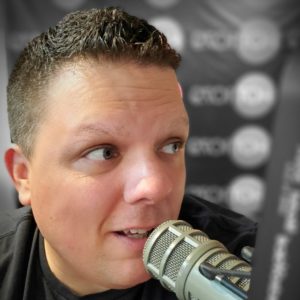
By Fred Deane
Kobe, Digital Content & Imaging Director/afternoon-drive, WZNE/94.1 The Zone, Rochester

Kobe
Kobe was recently named Digital Content & Imaging Director/afternoon-drive guy at WZNE/94.1 The Zone in Rochester for Stephens Media Group. For the CHR veteran programming and air-talent, it was a shift in his successful career from the world of Top 40, to the land of ALT. I think it’s safe to say that blurred lines exist among many contemporary music formats in our current era of programming, especially in the presentation and execution in both the programming and on-air fields.
In this DMS Guest Perspective, Kobe steps aside from the myriad of daily duties he’s absorbed with his new gig to give us some insight into the similarities and differences that he perceives to exist between the two formats he now has first-hand experience in.

“You should read Who Moved My Cheese, then definitely re-read Who Moved My Cheese,” I said to myself upon agreeing to my next career stop. If you’ve ever been presented with a shift in your life, job, or anything that matters to you personally, that book may have been suggested to you.
I told myself to re-read it because where I was headed was unchartered waters. After almost twenty-five years at CHR (mostly being a PD mind you) I was headed back to my hometown of Rochester to do…Alternative?
I was filled more with intrigue and excitement than I was anxiety. The first thing that hit me was just how Pop-flavored ALT is right now.
Artists like Tame Impala, Glass Animals, I Don’t Know How But They Found Me, Bakar, and more, lean towards Pop. But it makes sense if you think about it. The ALT icons of the past, like Green Day, Pearl Jam, Nirvana and several more from the mid 90’s, were an alternative to that generation’s Hard or Active Rock. The guitars were still present, with a heaping dose of rebellion and rage against authority similar to ALT’s cousin Punk Rock which came a few decades before.
But now, since the 90’s music has shifted, digital (dare I say electronic) production has changed the landscape of not only music, but multiple formats. Hence, it makes total sense that whatever is “Alternative” in 2020 has a Pop sound to it.
The transition to Alternative was much easier than I thought it would be, in fact I don’t think there could be a better time for a CHR jock to move to ALT radio as PM drive/Director of Digital Content. With ALT having that Pop lean to it, theoretically more females would be (and should be) attracted to the format. Therefore, I reasoned, it makes sense to have a jock who is comfortable talking and connecting to women to embrace those new listeners. I don’t specifically target females for my content, as much as I make it female-friendly. I try to paint as broad of a stroke as possible. If I can make seven out of ten people listen longer, or laugh…mission accomplished.
What even is a format anymore? Do our listeners know what “format” we are by the music we play? Or do they just listen for songs they like regardless of what station is playing it? I think we have perpetuated the notion of breaking down the walls of format-labeling by how we fill shifts now.
How many times have you had to track a shift as fill-in on another station in your building? Personally, I’ve had to track on Hot AC, Rock, and CHR, in the same market no less! Think of that twenty years ago. What if your GM came into the studio and told you he wanted you to fill in for the night show on your sister station whose format was totally different? You’d think he was joking, but now it’s common for that exact scenario to occur frequently. We’ve shown our listeners that we think it’s okay for multiple stations to share talent, regardless of format… so what is a format in 2020?
Format fluidity is at an all-time high. Music is accessible to listeners anytime they want, on multiple platforms. It’s the ultimate in instant gratification. Want to hear any song you want? Simply scan YouTube, Spotify, SoundCloud, Pandora, and many more like-kind platforms. Take a peek into their playlists, do you think you’re only going to find one type of music?
Think of all the collaborations that are commonplace these days between artists that may not have occurred twenty years ago. Country stars like Kane Brown working with Marshmello, and also Hip-Hop stars like Swae Lee, Kelsea Ballerini collaborating with The Chainsmokers, and Halsey. The lines separating formats now are blurred, if not totally erased. Good content is universal, regardless of format.
Fifteen years ago, job security was in programming. I had two roads in front of me when I was at B94 in Pittsburgh. One road was to see how high of a market I could achieve as a jock, the other road, which I thought was more secure (and at that time was), was to start my path as a PD.
Our industry has drastically changed from that point a decade and a half ago. Programming (by and large) is now handled by corporate programmers at multiple companies. The role of the PD has changed considerably. While interviewing over the past seven months before I landed back in Rochester, it was apparent to me that PD jobs aren’t as much about picking music anymore…it’s about how can you get more attention for your brand!
That said, I always had an urge to get back on the content side of things both on-air and in a bigger digital capacity. Utilizing everything I’ve learned digitally and applying it to all the brands here at SMG/Rochester is very exciting! Taking what we do on a daily basis and making it consumable for several different digital platforms is a way to constantly keep the content machine going. Hosting a show live every day was the missing piece I had been searching for, and I got it back. I’m thrilled to be having fun on the air every day, trying new things on the air, and being as engaging as possible with as many of my new listeners as I can.”

